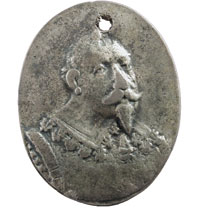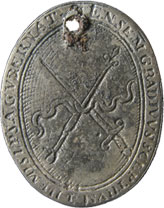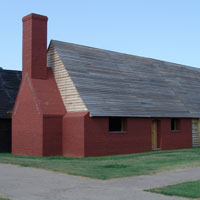Swedish Medal
Mystery Medal
During investigations at Van Sweringen’s Council Chamber site in the 1970s, an excavator made an exciting discovery. It was a small silver medallion, only 22.2 millimeters (0.9 inch) in height, with the unmistakable likeness of Swedish King Gustavus Adolphus II (1611-1632). A small hole above the portrait suggests the medallion was worn on a string or chain. On the reverse side, a crossed sword and scepter bisected by what appears to be a snake is pictured with a surrounding inscription “ENSEM GRADIVVS SCEPTRUM THEMIS IPSA GVBERNAT.”
Recent analysis has helped resolve some of the mystery surrounding this rare object. Latin scholar Linda Hall at St. Mary’s College of Maryland was asked to translate the motto. Her reading is “Gradivus Governs the Sword, Themis Herself Governs the Scepter.” Gradivus is a term for he who walks in battle, indicating Mars, the god of war, and Themis was the goddess of justice. “The motto probably recognizes the combination of remarkable military skills and just governance of the Swedish king known as Gustavus Adolphus the Great,” said HSMC director of research Dr. Henry Miller. Gustavus Adolphus organized the strongest army of the early seventeenth century and made Sweden the dominant Baltic power for the next one hundred years. After he was killed at the Battle of Lützen in 1632, he became known as Gustav Adolf the Great by decree. The sword and scepter support the motto and the snake is a heraldic symbol of wisdom. Further research will likely yield more insights regarding this phrase and the symbols.
Eva Wisehn, senior curator of the Myntkabinettet (the Royal Coin Cabinet), in Stockholm, explained that this is a medallion probably made in Germany after the king’s death. There are about 100 different versions of the medallion, made in different types of metal, that are often found in Europe, especially Germany. She concludes that it was not a coin but “a token of remembrance of the hero king.” To her knowledge, it is the oldest representation of the Swedish king yet found in North America.
We’ll never know for certain how this medal commemorating a Protestant Swedish warrior king was lost in St. Mary’s, but researchers have theories. The first building on the Van Sweringen site was a meeting place and government records office constructed by the colony in 1664. It served for 12 years until the new brick state house was built. “It is quite possible that one of the Swedes or Finns who moved to Maryland from New Sweden (along today’s Delaware River) lost this medallion while coming to the office to record his land patent or file his petition to become a citizen of Maryland,” Dr. Miller speculates.
“Perhaps the medal belonged to Van Sweringen, although it is unlikely that he would have worn it. He was a Dutch Catholic; it seems an image of a Protestant Swede would have had little appeal to him. Maybe someone who visited Van Sweringen’s elegant inn during its heyday in the 1680 and 1690s carried the object, although interest in Gustavus Adolphus must have been waning five decades after his death.” An earlier loss by a Swede seems more likely and better matches the site’s history. In any case, it is good evidence of the international nature of the Atlantic World and the multi-ethnic composition of settlers coming to Early Maryland.

Obverse side

Reverse side

The new Van Sweringen exhibit at HSMC


